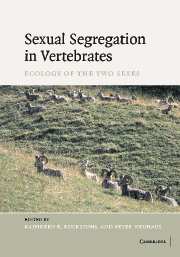Book contents
- Frontmatter
- Contents
- List of contributors
- Preface
- Part I Overview
- Part II Concepts and methodology
- Part III Foraging ecology
- Part IV Predator avoidance and reproductive strategies
- Part V Sex-related activities and social factors
- Part VI Sexual differences in ecology: comparisons within different taxa
- 13 Ecological divergence between the sexes in reptiles
- 14 Sexual segregation in Australian marsupials
- 15 Social systems and ecology of bats
- 16 Sociality and ecology of the odontocetes
- 17 Sexual segregation in non-human primates
- Part VII Implications for conservation
- Part VIII Outlook
- References
- Index
16 - Sociality and ecology of the odontocetes
Published online by Cambridge University Press: 04 September 2009
- Frontmatter
- Contents
- List of contributors
- Preface
- Part I Overview
- Part II Concepts and methodology
- Part III Foraging ecology
- Part IV Predator avoidance and reproductive strategies
- Part V Sex-related activities and social factors
- Part VI Sexual differences in ecology: comparisons within different taxa
- 13 Ecological divergence between the sexes in reptiles
- 14 Sexual segregation in Australian marsupials
- 15 Social systems and ecology of bats
- 16 Sociality and ecology of the odontocetes
- 17 Sexual segregation in non-human primates
- Part VII Implications for conservation
- Part VIII Outlook
- References
- Index
Summary
OVERVIEW
Several years ago, I visited colleagues studying guanacos, Lama guanicoe, small South American camelids, in southern Chile. In just a few days, I was able to witness nursing bouts, mating attempts and births after which we could catch and tag the newborn. In my 20 year's studying beluga whales, Delphinapterus leucas, in the St Lawrence Estuary in eastern Canada, I have observed thousands of surface events but only five mating attempts, one possible birth, no nursing and we are still speculating on what belugas feed on! This might explain why whales and dolphins rarely feature in the primary literature on behavioural ecology. The most obvious reason is the difficulty facing a terrestrial mammal observing an aquatic one (Connor et al., 1998). Nonetheless, a few long-term studies initiated in the early 1980s are starting to change this. These studies, based on individual identification and genetic profiling have overcome some of the difficulties and revealed an impressive diversity among cetacean societies (see recent reviews in Mann et al., 2000b). They have paved the way for comparisons of cetacean sociality with that of their terrestrial relatives from which stem most theoretical work on the evolution of mammalian social systems (Norris, 1994; Clapham, 1996; Weilgart et al., 1996; Connor et al., 1998). In this chapter, I examine a particular aspect of odontocetes' or toothed whales' social life: sexual segregation. Odontocetes or toothed whales are a suborder of cetaceans, which includes porpoises, dolphins, beaked whales and sperm whales.
- Type
- Chapter
- Information
- Sexual Segregation in Vertebrates , pp. 303 - 326Publisher: Cambridge University PressPrint publication year: 2006
- 2
- Cited by



